Noctueliopsis is a genus of moths of the family Crambidae.

Grotella is a genus of moths of the family Noctuidae first described by Leon F. Harvey in 1875.
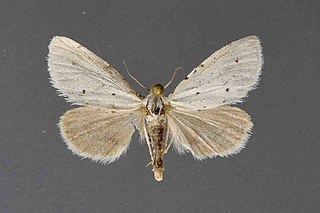
Grotellaforma is a monotypic moth genus of the family Noctuidae erected by William Barnes and Foster Hendrickson Benjamin in 1922. Its only species, Grotellaforma lactea, was first described by Stretch in 1885. It is found in North America, including California and Arizona, its type locations.

Grotella stretchi is a species of moth in the genus Grotella, of the family Noctuidae. This moth species was first described by William Barnes and Foster Hendrickson Benjamin in 1922. It is found in North America, including California, its type location.

Psammopolia wyatti is a moth of the family Noctuidae first described by William Barnes and Foster Hendrickson Benjamin in 1926. It occurs in western North America from southern Oregon to the Queen Charlotte Islands of British Columbia. The moth has been included in both 1983 and 2010 MONA indices.
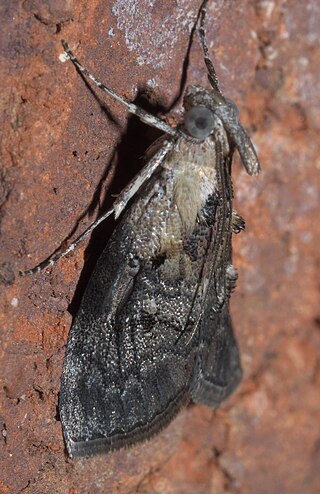
Pococera is a genus of snout moths in the subfamily Epipaschiinae, found mainly in North and Central America. It was described by Philipp Christoph Zeller in 1848.
Comadia dolli is a moth in the family Cossidae first described by William Barnes and Foster Hendrickson Benjamin in 1923. It is found in North America, where it has been recorded from Arizona, California, Nevada and New Mexico.
Comadia intrusa is a moth in the family Cossidae first described by William Barnes and Foster Hendrickson Benjamin in 1923. It is found in North America, where it has been recorded from New Mexico, Arizona and California.
Comadia subterminata is a moth in the family Cossidae first described by William Barnes and Foster Hendrickson Benjamin in 1923. It is found in North America, where it has been recorded from Arizona, Utah, Colorado and New Mexico.

Elophila gyralis, the waterlily borer moth, is a moth in the family Crambidae. It was described by George Duryea Hulst in 1886. It is found in eastern North America, where it has been recorded from Alabama, Florida, Georgia, Illinois, Indiana, Iowa, Louisiana, Maine, Maryland, Massachusetts, Michigan, Minnesota, Mississippi, New Brunswick, New Hampshire, New Jersey, New York, North Carolina, Nova Scotia, Ohio, Oklahoma, Ontario, Pennsylvania, Quebec, South Carolina, Tennessee, Texas and Wisconsin.
Eudonia bronzalis is a moth in the family Crambidae. It was described by William Barnes and Foster Hendrickson Benjamin in 1922. It is found in North America, where it has been recorded from California.
Noctueliopsis bububattalis is a moth in the family Crambidae. It was described by George Duryea Hulst in 1886. It is found in North America, where it has been recorded from Arizona, California, Colorado, New Mexico, Texas and Utah.
Noctueliopsis palmalis is a moth in the family Crambidae. It was described by William Barnes and James Halliday McDunnough in 1918. It is found in North America, where it has been recorded from California, Nevada and Texas. The habitat consists of high and low elevation deserts.
Noctueliopsis pandoralis is a moth in the family Crambidae. It was described by William Barnes and James Halliday McDunnough in 1914. It is found in Mexico and the southern United States, where it has been recorded from New Mexico.
Noctueliopsis puertalis is a moth in the family Crambidae. It was described by William Barnes and James Halliday McDunnough in 1912. It is found in North America, where it has been recorded from Arizona, California and Texas.
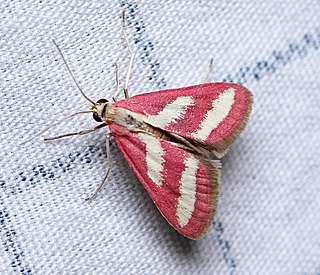
Noctueliopsis rhodoxanthinalis is a moth in the family Crambidae. It was described by Eugene G. Munroe in 1974. It is found in North America, where it has been recorded from Texas.
Noctueliopsis virula is a moth in the family Crambidae. It was described by William Barnes and James Halliday McDunnough in 1918. It is found in North America, where it has been recorded from Arizona, California and Nevada.
Apilocrocis pimalis, or the Pima apilocrocis moth, is a moth in the family Crambidae. It was first described by William Barnes and Foster Hendrickson Benjamin in 1926.
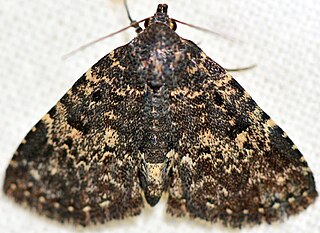
Metalectra diabolica, the diabolical fungus moth, is a moth of the family Erebidae. The species was first described by William Barnes and Foster Hendrickson Benjamin in 1924. It is found in North America, where it has been recorded from North Carolina to Florida and Arkansas to Texas.
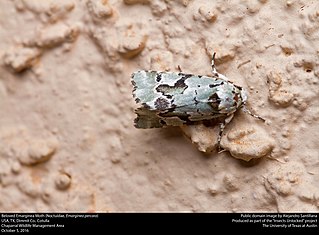
Psaphidini is a tribe of owlet moths in the family Noctuidae. There are at least 40 genera and at least 90 described species in Psaphidini.








